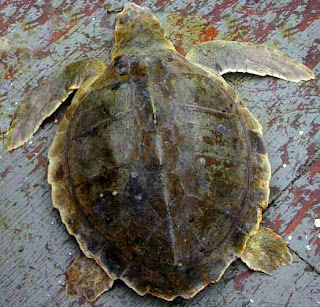 TOPSAIL BEACH, N.C. (AP) - All eagerly splashed around their tanks, almost sensing that their time to go home was growing near.
TOPSAIL BEACH, N.C. (AP) - All eagerly splashed around their tanks, almost sensing that their time to go home was growing near.There was Warrior, who was recovering from a skull fracture; Surf City II, who had a bad experience with fishing gear; Tripod, who was missing a flipper; and two other sea turtles that also had finished their treatment at the Karen Beasley Sea Turtle Rescue and Rehabilitation Center.
But there was something unusual about this year's annual late-summer release from the Topsail Beach-based facility.
All five of the turtles being returned to the Atlantic on Tuesday afternoon were Kemp's ridleys.
"It's like this is the year of the Kemps," said team leader Karen Sota, noting that the hospital has seen more Kemp's ridley turtles this year than loggerheads and green turtles combined. "And we really don't know why."
They are considered the most endangered sea turtle in the world, are exceedingly rare visitors on North Carolina beaches and receive strict protection under both federal and state law.
Yet Kemp's ridley turtles have been showing up this year in increasing numbers in North Carolina's coastal waters and in fishermen's nets.
The result has been a surge of juvenile Kemp's ridleys finding their way to the sea turtle hospital suffering from an assortment of ailments and a potentially growing headache for state fisheries officials, who are struggling with how to keep fishermen fishing while staying in compliance with the federal Endangered Species Act.
That sea turtles and fishermen sometimes run into conflict while sharing the same bodies of water isn't unusual.
"The problem is we haven't seen a lot of Kemps until now," said Marine Fisheries Director Louis Daniel, noting that historically its been juvenile green turtles getting snared in the gill nets.
Because greens have been the sea turtles caught in the greatest numbers in the past, the federal "take" permit allowing the state's gill net fishermen to interact with the endangered animals allows the most leeway with that species.
 But this summer, most of the observed incidents have involved Kemp's ridleys.
But this summer, most of the observed incidents have involved Kemp's ridleys.If that trend continues, it could prove challenging to keep the fishery open for very long especially under the number of Kemp "takes" the division has requested from National Marine Fisheries in its new gill net permit application.
But a study released this summer by the nonpartisan National Research Council found that a lack of solid data on sea turtle numbers can make it difficult for regulators to determine reasonable conservation measures.
There's little chance in the short term of more leeway, however, especially with the impact of the Deepwater Horizon oil spill on the Kemp's nesting beaches in the Gulf still unknown. So state fisheries officials are aggressively looking into ways to develop more turtle-friendly fishing gear and practices.
But no one knows if any innovation will be enough to keep the fisheries open if there is a dramatic increase in the number of Kemp's ridleys foraging in state waters during the warm-water months.
A more basic question is where are the turtles coming from, and why now
According to state records, North Carolina saw zero Kemp's ridley nests last year and only three so far this year.
Biologists said that's normal, since the turtles rarely come ashore here to nest.
So where are all of the juvenile turtles coming from? Are they fleeing the oil spill in the Gulf, or is this just a one-year anomaly, possibly tied to the exceedingly warm ocean temperatures we've seen this year?
Or is it simply the case of the conservation measures that began several decades ago finally bearing fruit?
While she hopes that's the case, sea turtle hospital Director Jean Beasley on Monday cautioned that one good year doesn't make a trend especially with a population so fragile as the Kemp's ridleys.
"But it is a good sign," she said. "Considering where they were, we'll take it."


